Types of Bridges: An Overview

Bridge is defined as a rigid structure that spanning horizontally between the supports built to provide a passage over an obstruction. The obstruction may be roadway, railway, river or valley. Here is a list on the types of bridges which are classified based on various categories as follows:
- Structural form of Superstructure
- Construction Materials Used
- Usage
- Interspan Relation
- Service Period
- Movement of parts of the bridge
- Navigation facility
- Position of bridge floor relative to the superstructure
- Submergence Condition
- Level of Crossing
- Bridge Span
- Alignment of the Bridge
Types of Bridges based on Structural Form of Superstructure:
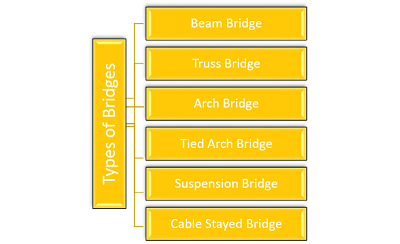
Beam Bridge
Beam bridge is the oldest type of bridge ever used by man. It can be defined as one or more horizontal beams which is/are supported at both the ends. The load over the beam is directly transferred to piers at the end of span. This type of bridge may be simply supported or continuous. It is also less expensive to construct. Beam bridges are constructed using steel or reinforced concrete.
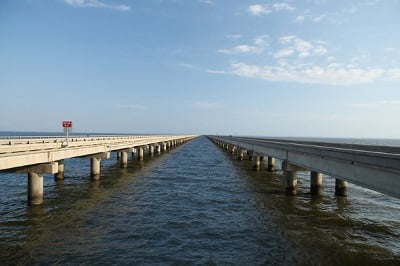
Truss Bridge
Truss is a structure of connected elements to form triangular units. The bridge deck is supported by means of steel trusses. This type of bridge is economical, efficient and is most commonly used in railways. Truss bridges can be easily prefabricated in factories and can be erected at site.
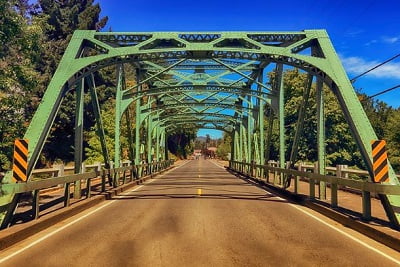
Arch Bridge
It is one of the oldest forms of bridges. The arch is located below the deck slab. The load on the deck slab gets transferred through the arch by compression to the abutments. The abutment (i.e., support) provided at each end of the arch prevents the bridge from spreading out. Arch Bridges use masonry, stone, concrete or steel as construction material.
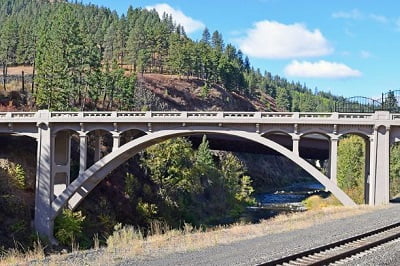
Tied Arch Bridge
Tied Arch Bridge is similar to arch bridge. But, the arch lies above the bridge deck. The cables suspended from the arch, support the deck slab. Also known as “Bowstring Bridge“
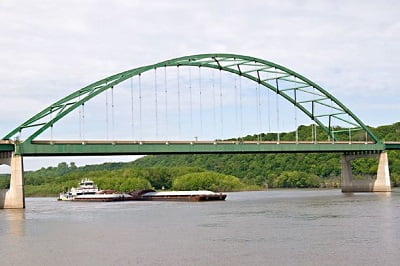
Suspension Bridge
In suspension bridge, the cables support the deck slab which are in turn attached to the suspenders. The suspenders are the curved cables running on either side of the bridge and throughout the length of the bridge. The suspenders are connected to two towers and must be firmly anchored into the ground at its ends. This type of bridge is suitable for longer spans. Also, suspension bridge provides an aesthetic appearance.

Cable Stayed Bridge
It is similar to Suspension bridge. But, the cables supporting the deck slab are connected to tall vertical towers called as pylons. The height of the pylon is much greater than that of towers in suspension bridges. Cables are usually connected to pylons in two different ways as follows:
- Harp design – The cables are connected to the pylon at different heights.
- Fan design – All the cables are connected at a particular height of the pylon.
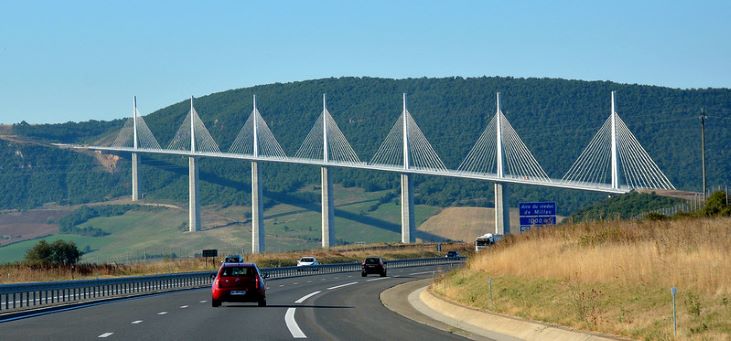
Types of Bridges based on Construction Material used:
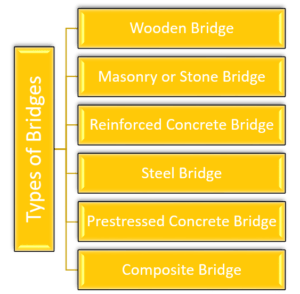
Wooden Bridge
It is one of the known earliest type of bridges. The material used for the construction of this type of bridge is timber. It is suitable for small and medium span enabling the movement of pedestrians, low weight car transport or livestock; commonly used for temporary purposes.

Masonry Bridge or Stone Bridge
Stone Bridge or Masonry Bridge uses Stone or Bricks as construction material. This type of bridge is comparatively durable than wooden bridges. It is suitable for shorter span enabling the movement of pedestrians and livestock. Usually, arch bridge will be of stone or masonry structure.

Reinforced Concrete Bridge
Reinforced Cement Concrete(RCC) Bridge uses Reinforced Concrete as construction material. RCC bridges are more stable and durable. It is most commonly used for constructing highway bridges and flyovers
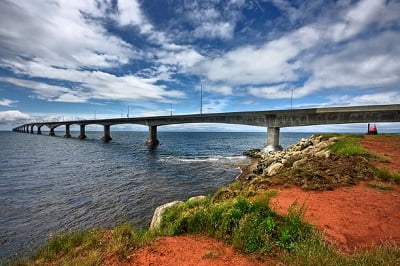
Steel Bridge
Steel bridges are constructed using steel bars, steel trusses or cables. It can withstand heavy loads and are suitable for longer spans. Steel bridges are commonly seen in Railways.
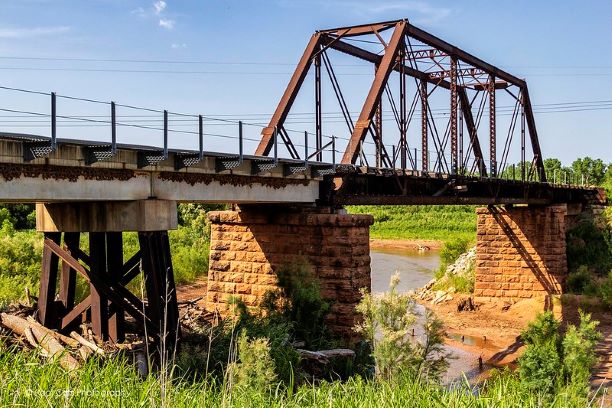
Prestressed concrete Bridge
Prestressed Concrete Bridge uses Prestressed Concrete as construction material. These types of bridges are suitable for shorter span to longer span. This type of bridges are either cast in site or factory made.
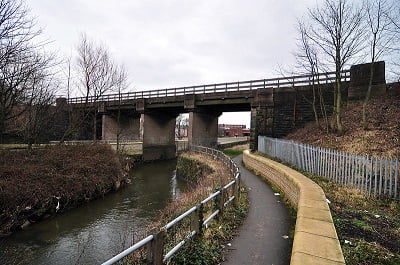
Composite Bridge
The bridges constructed by the combinations of more than one of the above discussed materials are called as Composite Bridges. RCC Deck slab resting on prestressed girders is an example of composite bridge.
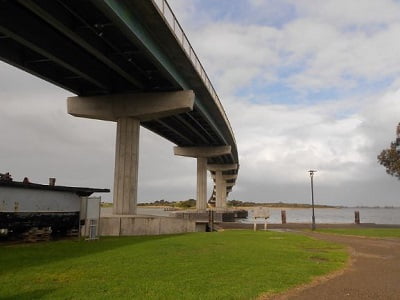
Types of Bridges based on Usage:
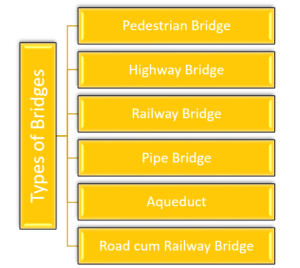
Pedestrian Bridge (Or) Foot Bridge
The Pedestrian Bridge is the bridge which enables only pedestrians to pass over the obstacle. No vehicles move over the bridge other than bicycles.
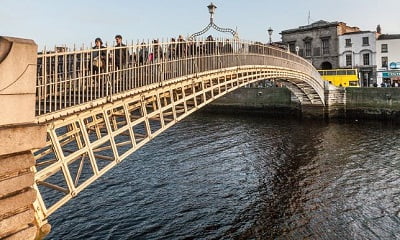
Highway Bridge (or) Roadway Bridge
The bridges constructed for the purpose of movement of vehicles over an obstruction is classified as Highway or Roadway Bridge.
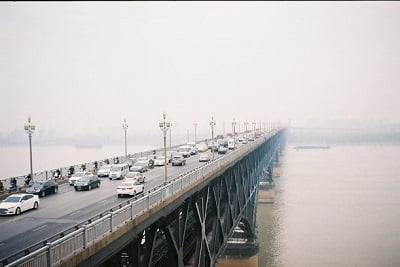
Railway Bridge
This type of bridge enables the movement of trains over an obstacle. Steel (Truss) Bridges are most commonly used for this purpose.
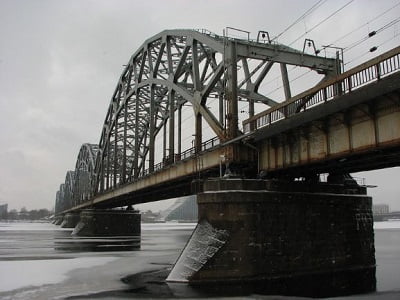
Pipe Bridge
Pipe bridges are bridges that support pipelines for gas, oil, water, communication cables, etc., Pipe Bridges include walkways which are utilized only during maintenance. Also, the public movement is restricted in walkways.
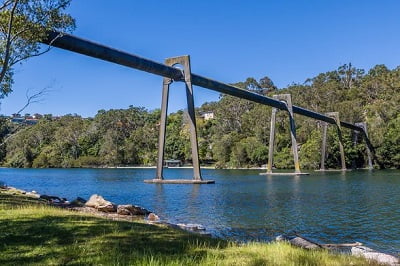
Aqueduct
Aqueduct is a structure used to transport water from one location to another over an obstacle.
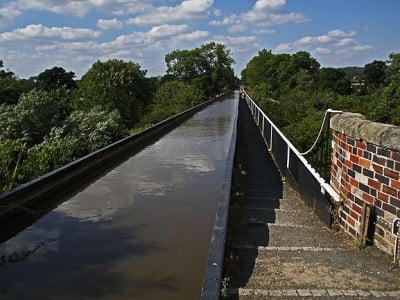
Road cum railway Bridge
Road cum Railway bridge enables both railway and road transport. It can have either single deck or multi decks.
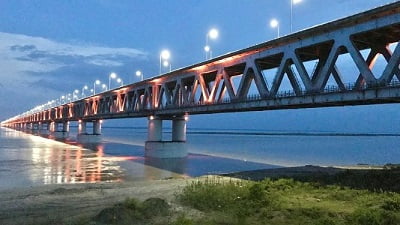
Based on Inter span relation:

Simply Supported Bridge
Simply Supported Bridge is similar to a simply supported single span beam which has supports at its ends. the bridge deck is simply supported at both its ends. It is suitable for shorter spans.
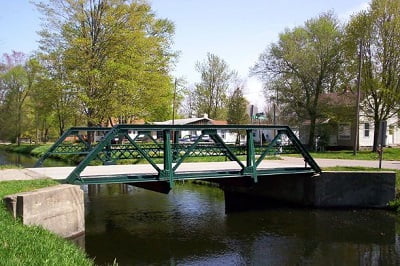
Continuous Bridge
If a bridge is continuous over more than one span (i.e. bridge spanning over more than two supports), then it is called as continuous bridge.

Cantilever Bridge
It is similar to cantilever beam which is fixed at one end and the other end is free. Cantilever bridge is adopted when the supports cannot be placed in specific locations. The two cantilever portions of the bridge are usually joined together. In general, Cantilever beam will have three spans. The middle span of the bridge is constructed as a cantilever.
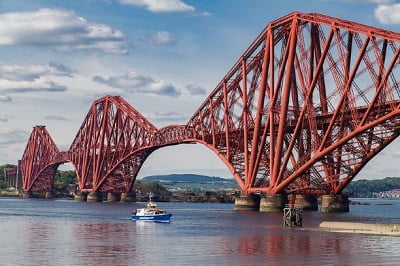
Based on Service Period:
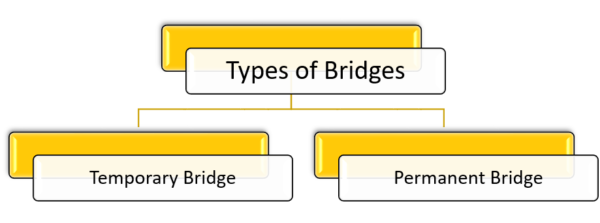
Temporary Bridge
The bridges constructed for short term usage are classified as Temporary Bridges. These bridges can be dismantled after the purpose of construction have been served. Temporary Bridges are usually low cost bridges. An example of temporary bridge is that a bridge constructed during floods for evacuation.
Permanent Bridge
These bridges constructed with a view to be used for longer duration are called as Permanent Bridges. Steel and Reinforced Concrete Bridges comes under this category.
Based on the movement of bridge parts:

Fixed Bridge
The bridge which is fixed in a particular location is termed as Fixed Bridge. This type of bridge remains in the same location until its failure. Mostly, the fixed bridge does not contain any movable parts. The bridge deck is at a higher level enabling clearance for water transport under them.
Movable Bridge
This type of bridge contains movable parts. The bridge deck moves to permit the passage of boats underneath them. This type of bridges may be dismantled and assembled in other locations.
Based on Navigation Facility:

Swing Bridge
This type of bridge can rotate horizontally with respect to a vertical support provided at the center of the span. The rotation of the bridge deck enables the movement of ships to pass through them.

Bascule Bridge
This type of bridge can lift its deck upwards allowing the movement of ships. The counterweights provided at the end of the span provides stability of bridge deck during lifting.
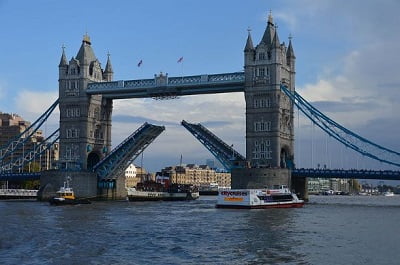
Traverser Bridge (or) Draw Bridge
The bridge deck moves over wheels or rollers. The bridge deck can be moved towards or away from the shore. The extended part of the bridge acts as cantilever.
Lift Bridge
The bridge in which the bridge deck moves up and down is classified as lift bridge. The vertical movement of bridge deck enables the movement of ships vertically from one water body to another.
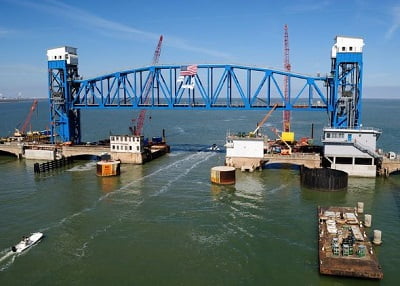
Based on position of bridge floor relative to the superstructure:
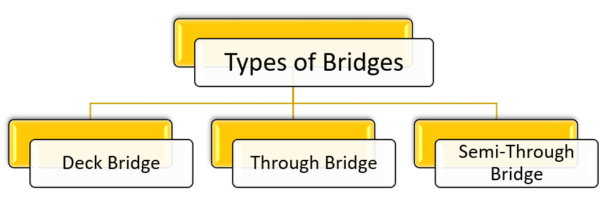
Deck Bridge
In Deck Bridge, the Bridge floor is provided at the top of the superstructure. Also, the bridge deck lies between High Flood Level and Formation Level.
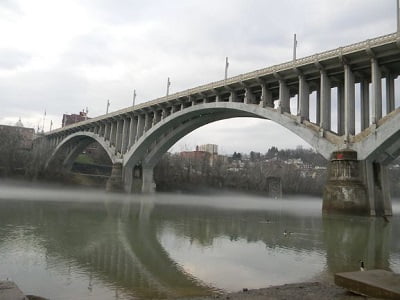
Through Bridge
In Through Bridge, the superstructure is completely above formation level. But the bridge floor is at the bottom of superstructure.
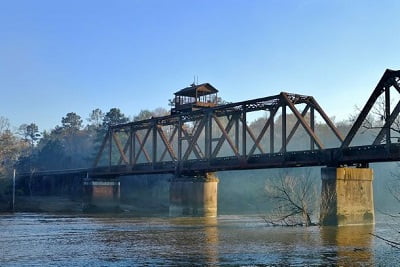
Semi Through Bridge
In Semi Through Bridge, the superstructure is partly above and partly below formation level. Also, the bridge floor is provided in the intermediate level of superstructure.
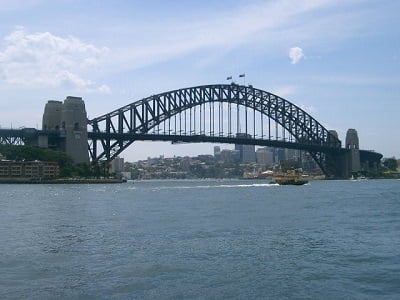
Based on Submergence Condition:

Low Level Bridge (or) Submersible Bridge
The superstructure of the bridge is below the High Flood Level of the water body. So, the bridge deck will submerge in water during the periods of high floods. These types of bridges becomes unusable during the periods of heavy rain.
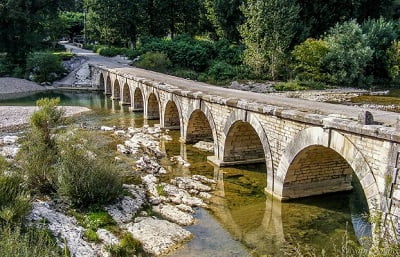
High Level Bridge (or) Non Submersible Bridge
The super structure of the bridge is above the High Flood Level of the stream or river. So the bridge deck will never submerge in water even during the periods of heavy rain.

Based on level of crossing:

Over Bridge (or) Fly over
The bridges passing over an existing route are classified as over bridge. The route over which the bridge passes can be either a roadway or a railway track.
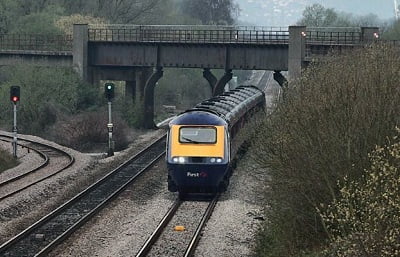
Under Pass
The tunnel passing under an existing route is termed as an Under pass. While constructing an underpass, considerations like drainage facilities and vertical clearance for vehicles must kept in mind.
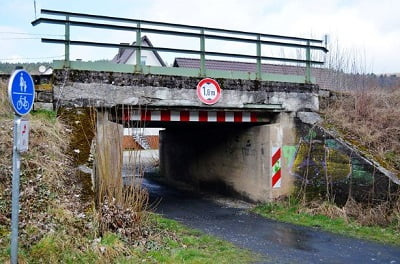
Based on Bridge Span:

- Culvert Bridge – The bridge of span less than 6 m is termed as Culvert Bridge.
- Minor Bridge – The bridges whose span is between 6 m and 60 m is classified as Minor Bridge.
- Major Bridge – The bridges whose span is between 60 m and 120 m is classified as Major Bridge.
- Long Span Bridge – The bridge of span greater than 120 m is termed as Long Span Bridge.
Based on the Alignment of the Bridge:

Straight Bridge
When the alignment of the bridge is perpendicular to the center line of the obstacle (like roadway, railway track or river), then it is called as Straight Bridge.
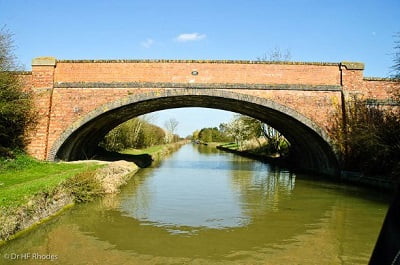
Skew Bridge
The alignment of the bridge is not perpendicular to the center line of the obstacle. Such bridges are called as Skew Bridge.
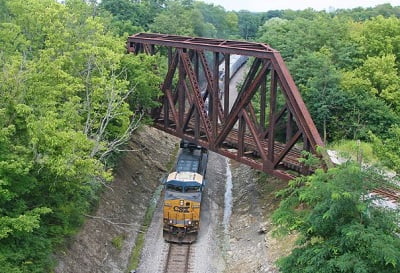
Types of Bridges PPT:
*To view a clear presentation, click on Full Screen View available at the right bottom of the PPT.





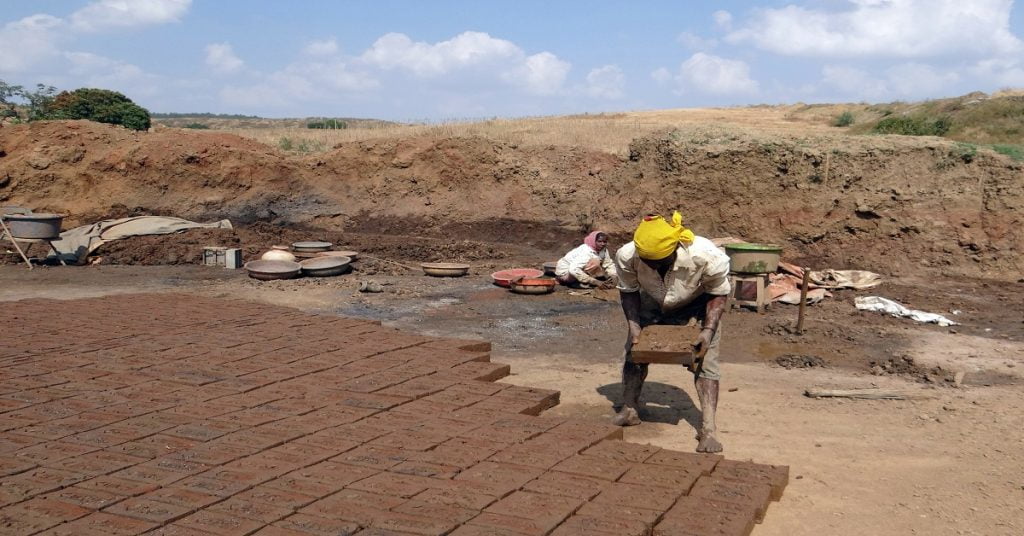
Very informative. Keep up the good work!